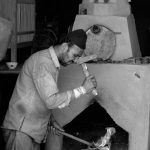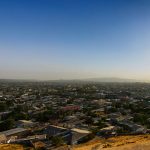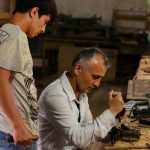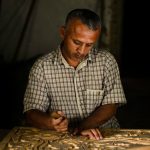Istaravshan, previously known as Ura-Tyube, is a historic open-air museum and mosque-abundant city in the north of Tajikistan’s Sughd province. With an impressive history that dates back over 2,500 years, it is one of the oldest cities in all of Central Asia. Once an important trading center for pottery, embroidery and other local arts and crafts on the Great Silk Road, Istaravshan’s creative legacy still lives on through its incredibly decorated mosques, mausoleums, madrassahs, fortifications, and statues, including one of the most notorious Vladimir Lenin busts.
Founded in the 6th-century by King Cyrus the Great of the Achaemenid Empire as ‘Cyropolis’, Istaravshan was once a fortified city with an intimidating six-kilometer city wall and a magnificent hilltop citadel. Today, only the ruins of the ancient ramparts and the Mug Teppe Fortress remain. Revamped in 2002 to mark the city’s 2500th birthday, the Istaravshan fortress is defended by an eye-catching brick gate topped with two blue domes. It was erected in the style of what the artists believed the original Fortress Mug Teppe entranceway would have looked like and is now a popular Instagram-worthy location.
The remarkable city of Istaravshan has a collection of historical and architecturally important monuments that tell the tale of its fascinating thousand-year-old history and culture. Don’t miss the massive concrete Istaravshan Lenin statue – one of the largest of its kind in the world – located on the outskirts of the city overlooking a lake in what seems to be the middle of nowhere. Visitors will need to climb about 300 steep steps to reach this hilltop statue that is one of the most famous attractions in Istaravshan. In fact, Istaravshan’s Lenin bust is bested in Tajikistan only by the famous Lenin statue in Khujand, the largest in Central Asia, which was relocated to Victory Park.
With a primarily Muslim population, pleasing Islamic influences reign in Istaravshan. Admire the significant Islamic architecture in Istaravshan at the extraordinary Savriston Mosque and the Khazrati Shokh mausoleum in Istaravshan, made up of three buildings from the 18th and 19th centuries: the Khazrati Shokh mausoleum (also known as the Hazrati Shoh mausoleum), the Khudoyor Valami mausoleum, and the Khazrati Shokh mosque (also known as the Namozgokh mosque).
The 15th-century Kok Gumbaz Madrassah with its turquoise dome, the Mausoleum of Abu Abdurahman in Sari Mazor, Tajikistan with its gorgeous golden dome, the Sary Mazar tombs (the Yellow Tomb), and the modern Khavzi Sangin Mosque with its spectacular and colorful painted ceilings are also worth a visit.
When you have had your fill of the mind-blowing architecture and ancient monuments in Istaravshan city, the Old Town and its bazaar offer an authentic Tajikistan experience. Explore the historic center with its narrow streets and market stalls. A prominent fruit-growing center, the Istaravshan bazaar is the perfect place to get a taste of Tajik-grown grapes and pomegranates – particularly on Tuesdays.
Other Istaravshan attractions in Sugd Tajikistan include the picturesque Dashti Jum Nature Reserve, an important bird watching area that’s set to become a UNESCO World Heritage Site. Built by the Tajik Soviet State in 1983, it is one of four official nature reserves of its kind in Tajikistan. Visitors can explore the area on foot or four wheels and search for over 50 different species of mammals, including the rare Tian Shan brown bear, Central Asia mouflons, markhor wild goats and – very occasionally – snow leopards.
As Istaravshan is still relatively rural and not built up like other cities in northern Tajikistan – there are not many Istaravshan hotels – so it is best visited on a day trip from other Tajikistan cities such as Khujand, Panjakent or Dushanbe. Take a look at our Istaravshan Tajikistan map and northern Tajikistan itineraries for more information.













